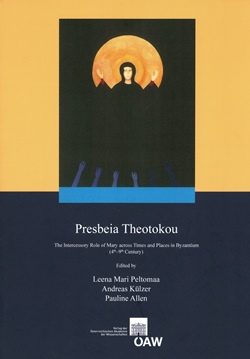


The idea behind the collection of essays in this volume is to bring into focus one main aspect of the Marian cult – the invocations of Mary – across the Byzantine Empire from the fourth to the ninth century. Over the span of the five centuries with which this volume is concerned, the empire turned into a thoroughly Christian society and at the end of Iconoclasm (843) the figure of Mary is found as the intercessor of the entire empire. Why and how this development took place is a question that challenges not only the study of the Byzantine cult of Mary but the study of Byzantine society in general. This volume will be a contribution to the search for an explanation proceeding from highly variegated sources and perspectives subsumed under the title, Presbeia Theotokou. It refers to the doctrine prevailing during this transformative period, which was uninfluenced by later ideas on the significance of Mary’s part in Christ’s role as redemptor.
It is agreed that regional diversity was an inherent element of the cult of Mary; the cult neither developed nor was established at the same time and in the same manner throughout the empire. The glimpses, given here, of different religious “landscapes” in Byzantine territory show first of all the cultural contexts where Mary’s intercessory role manifested itself. The selected regions – Palestine, Egypt, Constantinople, Syria, Antioch, Armenia, Durrës, Rome, Italy, and North Africa – cover a great part of the territory that was under East Roman or Byzantine rule. The contributors represent expertise in early Christian, Late-Antique and Byzantine Studies. The sources – objects, texts and documents – are examined from vantage points of archaeology, art history, papyrology, sigillography, patristics, religious studies and theology.
Gedruckt mit Unterstützung des Fonds zur Förderung der wissenschaftlichen Forschung (FWF).

…
Die Aufsätze, die das vorliegende Buch vereint, sind einem wesentlichen Aspekt des Marienkultes, den Anrufungen Mariens, Mutter Jesu von Nazareth, im Byzantinischen Reich zwischen dem 4. und dem 9. Jahrhundert gewidmet. Im Verlauf dieser fünf Jahrhunderte entwickelte sich das Reich, in dem pagane Vorstellungen und Traditionen anfangs noch wesentlichen Einfluss besaßen, zu einer rein christlichen Gesellschaft; am Ende des „Bilderstreites“ oder Ikonoklasmus im Jahre 843 war die Figur Mariens reichsweit als Fürsprecherin für die Gläubigen angesehen. Die Frage nach dem Wie und dem Warum dieser Entwicklung hat über die religiöse Dimension hinaus wesentlich mit den allgemeinen gesellschaftlichen Entwicklungen in Byzanz zu tun. Ausgehend von vielfältigen Quellen und Perspektiven versucht das vorliegende Buch zu einer Antwort beizutragen, und zwar in ausschließlicher Heranziehung der zeitgenössischen Vorstellungen jener bedeutsamen Umbruchszeit und in bewusster Abgrenzung zu später entstandenen mariologischen Vorstellungen. Ein wesentliches Phänomen des Marienkultes ist die regionale Unterschiedlichkeit: Der Kult entwickelte sich keineswegs zur gleichen Zeit in gleicher Weise allüberall im Reich, sondern formte sich in unterschiedlichen Regionen eigenständig und verschieden aus. Die hier behandelten „religiösen Landschaften“ Palästina, Ägypten, Konstantinopel, Syrien, Armenien, Albanien und Gebiete im Westen (Rom, Italien, Nordafrika) – gereiht nach der Wichtigkeit der Entwicklung – decken einen großen Teil des Byzantinischen Reiches ab; sie erlauben aufgrund der günstigen Quellen- und Überlieferungslage eindeutige Aussagen.
2015,
978-3-7001-7602-2
978-3-7001-7828-6
271 Seiten, zahlr. Abb.,
29,7×21cm, broschiert